How To Use Windows Powershell Commands
Have you ever tried to write some PowerShell lawmaking and got stuck? Worry no more! Ane of the all-time ways to get good at PowerShell is by agreement the nuts. Knowing a few basic PowerShell commands tin can make you a pro, and yous'll automate administrative tasks more efficiently.
In this tutorial, you'll learn the bones PowerShell cmdlets you demand to know to make your PowerShell experience more than interesting.
Prerequisites
This tutorial volition be a hands-on demonstration, but it doesn't have many prerequisites. If you'd like to follow along, whatsoever arrangement (Windows or Linux) with PowerShell 5.i or above will work. Although the commands are shown using Windows PowerShell, the examples beneath work in PowerShell 7+ cantankerous-platform.
Getting Help Information on Commands with Get-Help
Have you ever written code similar a boss without getting any help? Well, in that location would e'er be a need for help as you write code. Whether you're running lawmaking or commands in a command-line environment, the Become-Assist cmdlet comes in handy.
Let's start this tutorial by learning how the Get-Assist cmdlet works.
The Get-Help cmdlet offers you the guides needed to employ any command effectively without getting errors. Come across information technology every bit documentation for each of the PowerShell commands.
Open PowerShell equally an administrator, and run the Get-Help command below to view detailed (-Detailed) information about a command, such as the Go-ExecutionPolicy cmdlet.
Get-Help -Name Get-ExecutionPolicy -Detailed 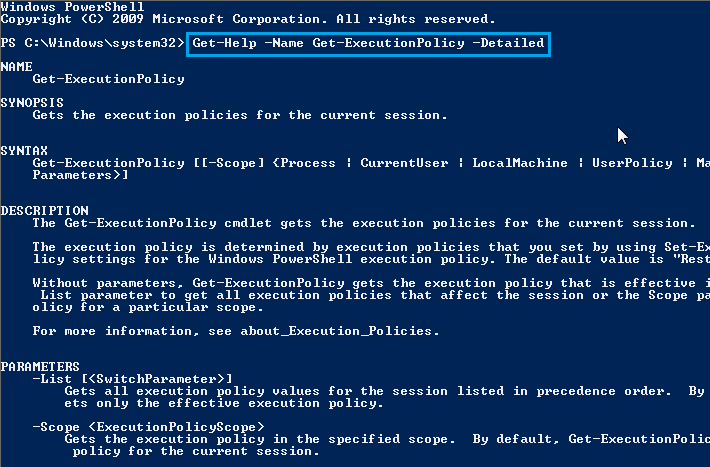
Instead of just detailed data, perhaps you lot desire to view full information about a cmdlet. If so, add together the -Full parameter in the Get-Help command instead.
Run the code below to go the full (-Full) information about the Become-Help cmdlet itself.
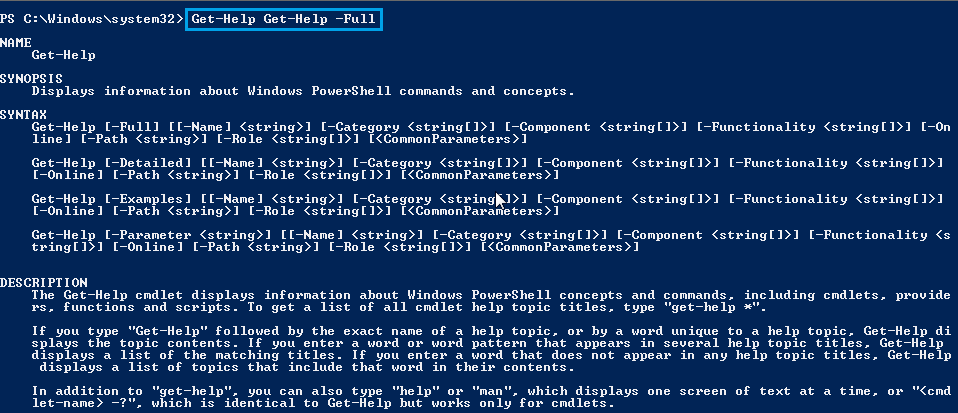
Perchance yous still need more examples to avoid errors when yous running the command. In that case, add the -Examples parameter to see examples of writing a command.
Run the Get-Help command beneath to get examples (-Examples) on how you can use the Get-Process cmdlet.
Go-Assistance Become-Process -Examples 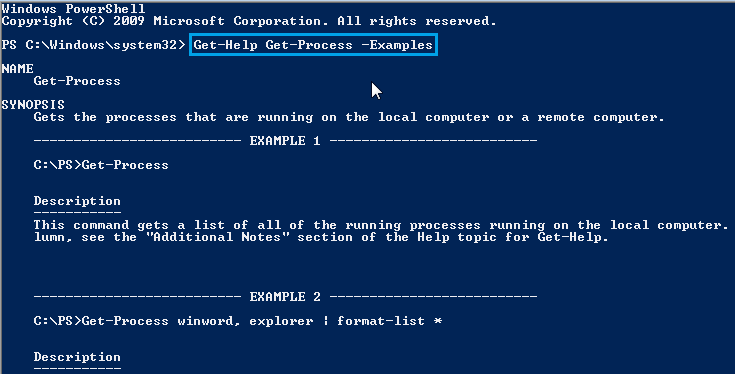
Retrieving Computer Processes with Get-Process
Practise you remember the Windows Task Director that displays all your processes, services, applications, and all of that? Good! The Get-Process cmdlet is a basic however essential cmdlet that gives you admission to all your computer's processes in a few steps without opening Task Manager.
Run the following control to get a list of all your organisation processes in a tabular array format.
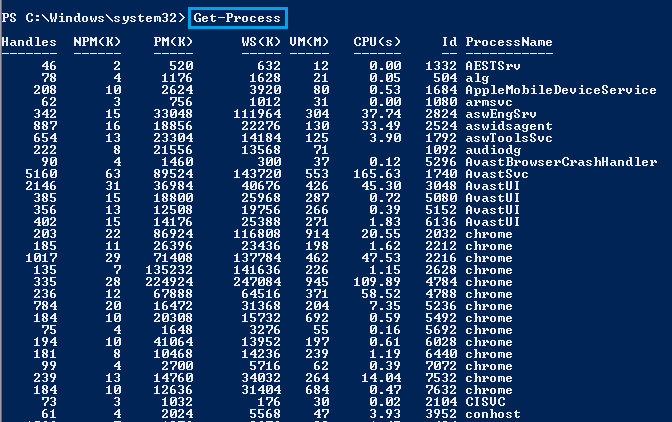
When a process freezes and causes your computer to piece of work slowly, stop the process past piping the
Get-Processcmdlet to theStop-Processcmdlet. For case: runGet-Process -Id 1252 | Terminate-Procedure, where-Id 1252specifies the process ID of the procedure you want to finish.
Fetching PowerShell Session History with Get-History
There might be a demand to check your recent commands, such as verifying if the contempo command you executed is correct or if you actually executed a command. But does PowerShell have commands history? Yes! The Get-History cmdlet returns an object of all your recent commands in your current PowerShell session.
Run the command below to get a listing of all the recently executed commands in your current session.
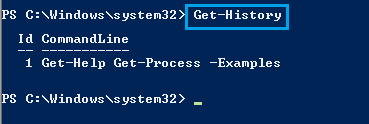
If you lot prefer to view specific commands from the history, add the
-Idparameter followed past the ID number of the control from the history. For example, runGet-History -Id twoto come across the 2d command in the history.
Displaying System Services with Get-Service
Similar the Get-Process cmdlet, PowerShell likewise lets y'all view all services running in your system. The Get-Service cmdlet lets you view all services, which could exist a database server or awarding that automatically controls the brightness of your figurer screen.
Run the command beneath to get a listing of all the services on your system in a table format. With this command, you go to view even stopped services.
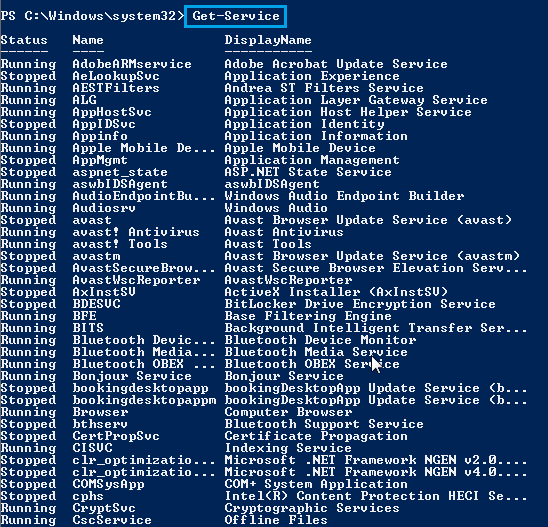
Perhaps you're looking for services that start with a specific character. If then, adding a wildcard character (*) will practise the fob.
Run the Get-Service command below, passing the kickoff letter of the alphabet and asterisk (A*) of the services you want to view. Calculation the wildcard grapheme lets y'all filter all the services which do not start with the letter 'A.'
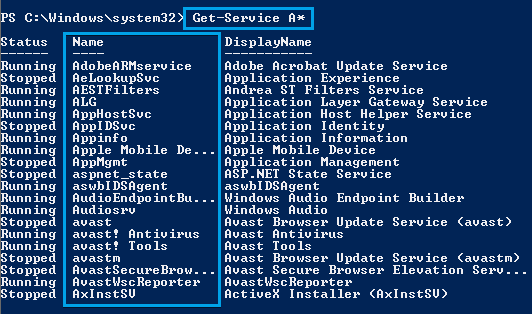
Running Background Jobs with Start-Job
Writing codes can become annoying if there's still and so much to write, merely a unmarried command takes forever to write. No trouble! PowerShell provides a cmdlet to run background jobs on your session. The Commencement-Chore cmdlet provides a PowerShell surroundings to run code or commands equally a background chore without user interaction.
Run the Start-Job control below to outset a background job for the Get-Command cmdlet. Starting a background job runs the Become-Command cmdlet without displaying the output on your command line.
Offset-Job -ScriptBlock {Become-Command} 
Since yous're groundwork jobs, how do you cheque if a job is still running or completed? Run the
Get-Jobcmdlet to become all the jobs in your session.
Irresolute Working Directories with Prepare-Location
There are times when you need to alter directories, such as when running a script or a program from a specific location. Merely how practise you lot change directories? Let the Set-Location cmdlet help you with that. The Ready-Location cmdlet sets the current working directory to the directory you specify in a command.
Run the code below to prepare the current working directory to C:\Users\hp\Desktop. Change hp with your calculator's username.
Set-Location C:\Users\hp\Desktop Beneath, yous tin see in the prompt that C:\Users\hp\Desktop is now the working directory.

Verifying If Paths Be via Exam-Path
PowerShell may display a issues if yous're trying to access a file that doesn't exist. How to avoid that? The Exam-Path cmdlet lets you check if a path exists or not, with its intuitive syntax.
Now, create a binder on the Desktop, naming it NewFolder.
Run the Examination-Path control below, followed by the path yous prefer to test. For this example, the command tests if the C:\Users\hp\Desktop\NewFolder path exists.
Test-Path C:\Users\hp\Desktop\NewFolder Beneath, y'all tin can see the command returned a True value since the path exists. Otherwise, you lot'll get a False output.

Converting PowerShell Object to HTML with ConvertTo-HTML
If you prefer an organized course for your information, convert your data to HTML with the ConvertTo-Html cmdlet. Fundamentally, the command takes in the output file you want to convert and the filename you want to salvage information technology with.
Run the command below to collect the list of all the PowerShell commands (Get-Command) in retentivity and convert (ConvertTo-Html) the list to an HTML file named Command.html.
The HTML file is saved on your Desktop since you previously changed the working directory. To save the HTML file in another location instead, specify the total path. For example:
Get-Command | ConvertTo-HTML > C:\Temp\Commands.html
# Creates a Commands.html file that contains all PowerShell commands Get-Control | ConvertTo-Html > Commands.html Exporting PowerShell Objects to CSV with Export-CSV
If you lot think a report in CSV would be better instead of HTML, then use the Export-CSV cmdlet. Similar to the ConvertTo-Html cmdlet, the Export-CSV cmdlet lets you lot export data to a CSV file.
Run the command beneath to collect a list of PowerShell commands (Get-Control), and export the list equally a CSV file (Consign-CSV) named Commands.csv.
Get-Control | Export-CSV Commands.csv Like in the ConvertTo-Html cmdlet, y'all can too specify an export path for the CSV file like this:
Get-Command | Export-CSV C:\Temp\Commands.csv
Open the Commands.csv file, and you'll see something like the one below. Not bad, right?
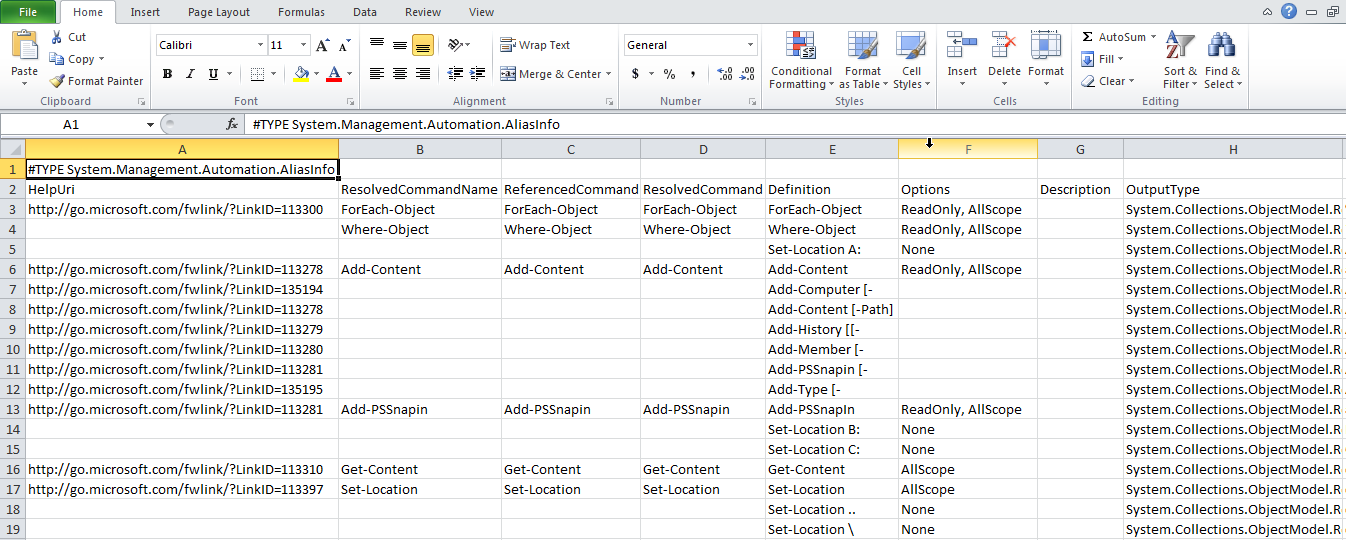
Viewing all Bachelor PowerShell Commands with Become-Command
The last PowerShell command on the list is the Get-Command cmdlet. The Become-Command cmdlet basically lists all bachelor PowerShell commands you lot can run in a table format. But every bit you've seen in the previous examples, you know that it'southward not all that the Become-Control tin can practise.
Possibly you want to listing the cmdlets or the aliases selectively. If so, add the -CommandType parameter to the Go-Control cmdlet to filter out the output by the command type you lot specify. The -CommandType parameter'due south value tin can be Alias, Cmdlet, or Function.
Run the Get-Command control beneath to list only cmdlets (-CommandType Cmdlet) with names starting with 'G' (-Proper noun Grand*).
Get-Command -Proper name G* -CommandType Cmdlet 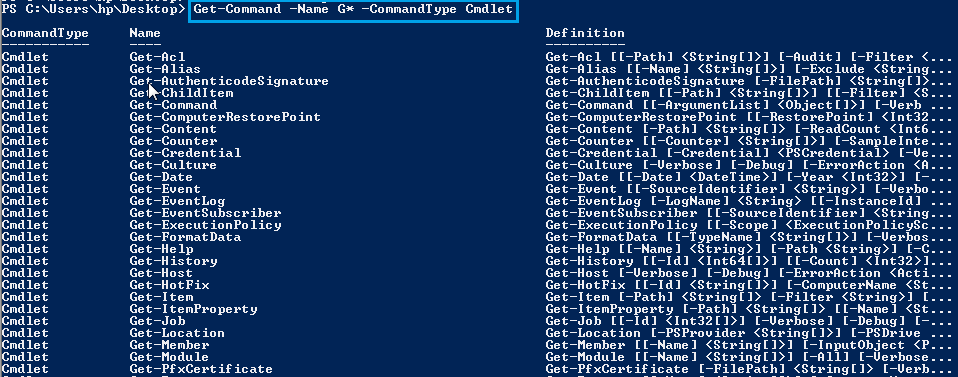
Another way of filtering the Get-Control output is past pipage information technology to the Select-Object cmdlet. As yous know, the object returned by the Get-Command cmdlet is in a tabular array format. In that table, the column names represent the backdrop you can select from the object.
Run the Become-Command below to collect a listing of all PowerShell commands and filter'due south the display to evidence each command's definition property (Select-Object -Holding Definition).
Go-Command | Select-Object -Belongings Definition 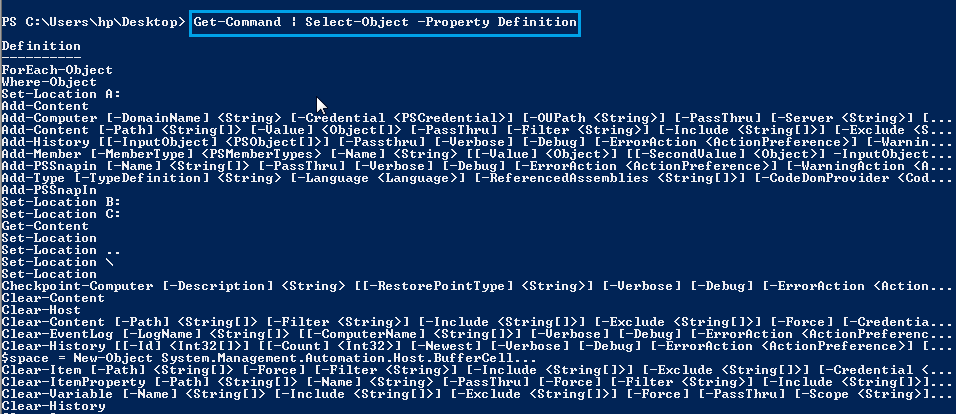
Decision
This tutorial has given you a thorough guide on running basic PowerShell commands. By at present, you should know how to extensively pipage and run commands and avoid getting stuck at coding anytime.
Now, how would y'all build on this newfound knowledge? Perhaps larn how to write multi-line commands in PowerShell scripts without messing things up?
Source: https://adamtheautomator.com/basic-powershell-commands/
Posted by: stewartowereve.blogspot.com

0 Response to "How To Use Windows Powershell Commands"
Post a Comment